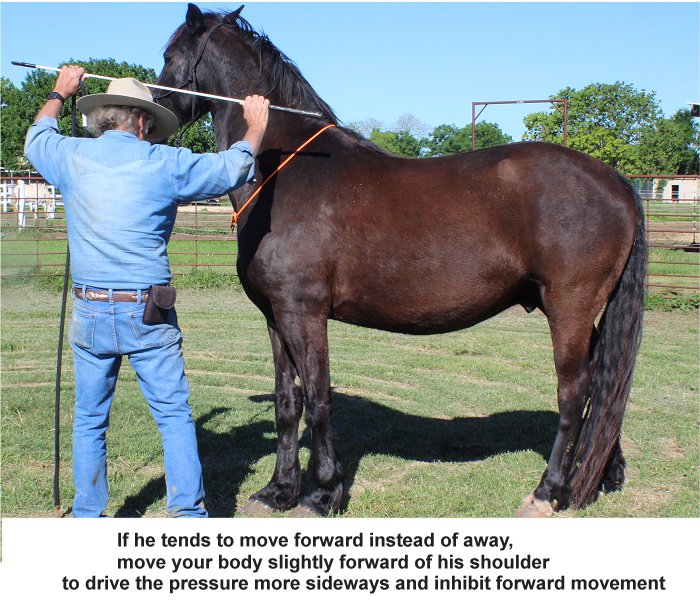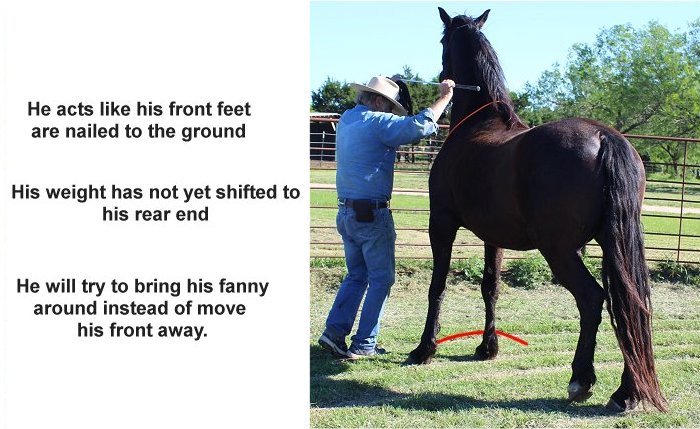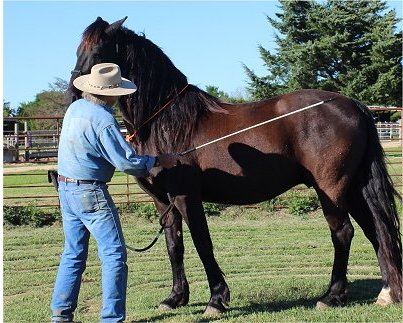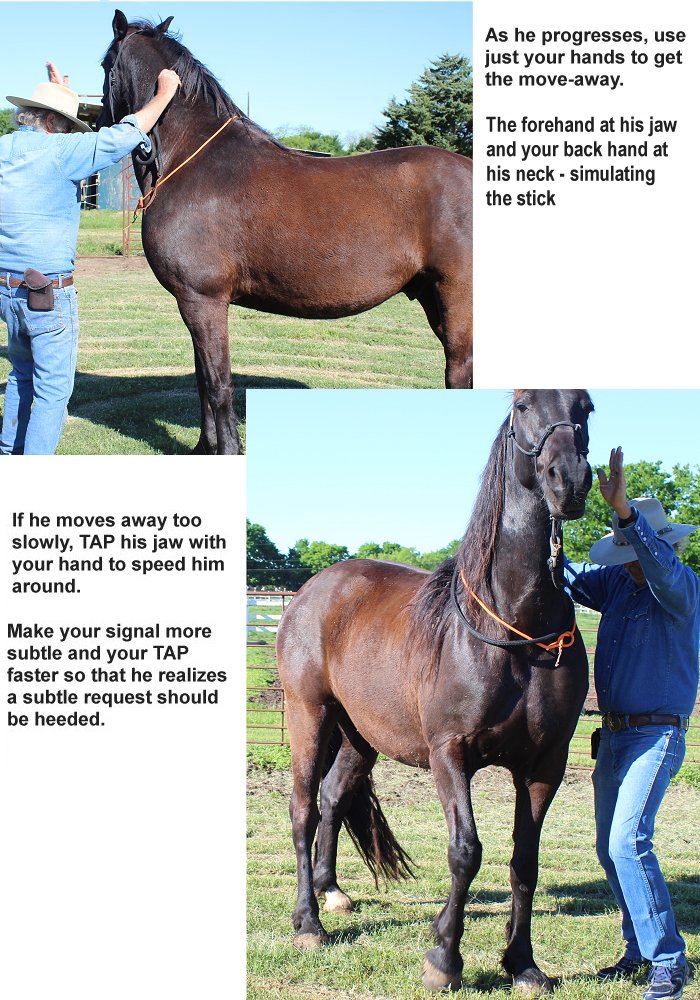Equipment Needed: Stiff Rope Halter with Nose Knots, a Training Stick (without the string), 14′ to 15′ Lead Rope
Training Needed: Backing Up and De-Sensitizing are necessary pre-requisites for this exercise.
A difference between pushing and driving. Pushing is a steady pressure that a horse can push back against. Driving is a rhythmic pressure that demands movement away from the driver.
The Object
There are many times that you want your horse’s head, neck, and shoulder to move away from you: when he is crowding your space, when you want him to turn around, during grooming, tacking and in tight spaces. This exercise is also early preparation for leg yields: shoulder-over, turns on the rear, cutting, spins, and collection. When you control his front end, you control his direction and his weight distribution.
The object of this exercise is to get your horse to move his head, neck and shoulder away from you with just a quick cue. It starts with a one step move-away (weight distributed to his rear to free the front for the move) requiring him to cross his close front foot over his far front foot. It continues moving his front away in the proper foot pattern and turning 360 degrees around the circle, pivoting on his rear as you just point and move into him or ask him with a light touch to the neck or shoulder.
As with backing up, there is not just one RIGHT WAY to teach this lesson. Different techniques work for different types of horses. Hot, skittish horse need something different than lazy, pushy horses need.
If you understand a stationary horse’s normal weight distribution, you will see that he is putting his weight squarely on the portion of his body that you want to move.
 In order to determine how a horse’s weight is distributed, horses were weighed at the Tarleton State University Equine Center. The average distribution was 57% on the front legs and 43% on the back legs. That information is important to this exercise. Read a New Perspective on Saddle Rigging
In order to determine how a horse’s weight is distributed, horses were weighed at the Tarleton State University Equine Center. The average distribution was 57% on the front legs and 43% on the back legs. That information is important to this exercise. Read a New Perspective on Saddle Rigging
Understanding his standing weight distribution, we begin to understand what it will take to re-distribute his weight to make it easier for him to move his front. Before we move his front away, we need to:
1. change his weight to his rear so that his move is easier (this may require a “back-up” maneuver)
2. get his off-side front leg out of his way so that his near-side front leg can cross over it without stumbling.
 While this trainer (right) may want the horse to move away from her, the front legs are not in the correct position. Notice that his off-side front leg is in front of his near-side leg, preventing the cross-over as she drives his front away.
While this trainer (right) may want the horse to move away from her, the front legs are not in the correct position. Notice that his off-side front leg is in front of his near-side leg, preventing the cross-over as she drives his front away.
3. know that a moving horse is easier to direct than a standing horse. Remember your physics lessons, “an object in motion tends to stay in motion, and an object at rest tends to stay at rest” AND “moving in a straight line is easier than turning”. For this reason it is best if your horse already knows how to back up, which instantly starts him moving and changes his weight distribution to his rear end.
Method 1: Stick Pressure at the Head and Neck
(Contains elements of Clinton Anderson Methods)
This method takes some stamina if you are small and the horse is big and lazy. I find it easier to get one of the guys at the ranch to teach it to our big Friesian Cross horses.
Standing at your horse’s neck/shoulder, grasp the lead rope at about 12″- 18″ and coil the rest around his neck loosely to keep it out of your way. Raise your stick to just above shoulder height in a horizontal position. Holding the stick with two hands (rope included in one hand), moving purposefully toward him, start pumping the air toward him with the stick in the same nice, steady rhythm we always use: air-tap, air-tap, air-tap, air-tap. If you get no movement, raise the energy of your stick to actually make contact: tap, tap, tap, tap.


Watch for him to take one front cross-step away from you. When you get your first crossover-step, stop, relax and rub his neck.
This is the time you can expect some beginner’s resistance or confusion. A lot of horses will move away but by backing up ever-so-slightly and crossing the near foot behind the far foot.
Your horse may try to push forward to avoid the stick. He may try to swing his rear around instead. He may just get confused and try 5 things at once. This lesson can get very messy until it is conquered! Don’t give up just because you feel so clumsy and the horse is so unsure of what to do.
If your timing is good, you can counter each move and stay persistent until the right move is tried. Accept it immediately by relieving the pressure and rubbing his neck.
Repeat. As he becomes more confident and easier to move, ask for two steps then three.
Likely Problems:
There are many types of horse personalities. The very jumpy, sensitive horse takes very little pressure to drive him away and over reacts to the introduction. The lazy but sensitive horse (that is the type I usually train) takes little pressure to get started, but frequently takes a quick, firm tap to get more energy into the try after the pattern is learned. The lazy and IN-sensitive horse takes a lot more pressure for both the intro and the finish energy. And the pushy, aggressive, IN-sensitive horse needs a firm hand from the very start.
If your horse pushes forward (the most likely first try), move your body a little forward toward his head to inhibit forward movement. That sends your move-away pressure a little more sideways at his head.
If he shoots by, pop the halter down on his nose a few times so that the nose-knots are uncomfortable. He must back up! Make him take many (10-20) steps backward, then re-adjust and start again with your body a little more forward of his shoulder.
 .
.
If he backs up to avoid the move, follow and tap his neck until the feet do the right thing. It usually means he is a little bit more sensitive and worried. He will find the right answer if you just keep a steady drive and wait for him to make the right step-away. Have patience. Keep driving with the stick until he makes the first correct cross-over move away. Then relax, rub, and take a deep breath.
Watch for his rear to swing around into you. Be prepared to change your stick hold and tap his rear firmly to get it to move away. Then prompt for the head and shoulder to move away again. It may take some time to get him to understand. Horses are not used to being directed this way.

If he continually steps behind instead of stepping across with the front feet, position your body a little further back to drive more forward movement. Up the pressure a tad. The faster the horse is turning away from you, the more likely that his feet will be working in the proper step.
The stubborn, pushy horse The disrespectful, pushy horse is definitely not used to being told what direction to go.
For this horse, change the angle of your stick to a one-handed, vertical stick. Place your head-hand forward (holding the 12″ of rope) to keep his head from coming toward you. Begin air-pressure, pumping both your hand and your stick toward his neck and head using the same rhythm we always use: air-tap, air-tap, air-tap, air-tap. Then physical Tap, Tap, Tap, Tap. THEN TAP! TAP! TAP! TAP!
Keep your hand and stick in the same rhythm. Your hand is driving and directing the head. Your stick is driving and directing his neck and shoulder.
The less response you get, the harder you tap/whack, escalating the pressure until it is uncomfortable enough to move away instead of take the licks. If you get a truly unmovable horse, escalate the pressure more quickly. Skip the middle steps and go from the air-tap right to the TAP! so he knows you are not joking.
This type of horse frequently tries to walk out of the lesson by going forward either during the request or just when he has done the correct stop. If that happens, bump on his nose and back him up forcefully away from you. Back up quickly and forcefully for several steps. Be aggressive. When you stop backing, re-position yourself a little further forward of his shoulder and start over.

He may try to push you with his shoulder or swing his butt into you. This takes a decisive and swift reaction with your stick to his shoulder or fanny. Then back him up again! A swift whack to the offending body part and an energized back-up is the best response to a horse who pushes with shoulder, ribs or butt.
Many reluctant, dominant horses will turn their head but not move their shoulder away. In that case, leave your hand pushing his head and tap further back on top of his shoulder to get it to move away.
Habitually pushy horses can turn this into quite a workout as they barge forward, back up, swing into you – generally try anything but taking a cross-over step away. Be prepared to change tactics with each mistake he makes.
Keep at it until you see the proper step-over. As you progress, ask for more and more steps with no problems in the middle.
Now you can move to a hand signal with no stick. After all, you will be asking for this maneuver during daily life with no stick in hand. Your hand-signal can become quite subtle if you ask quietly and then move quickly to Tap his jaw if you don’t get a quick response to a subtle cue.

When he has mastered this to the point that you know he knows what you are asking, he should spin ahead of you. If he runs into your hand on his jaw because he is slow, that is his problem. He needs to pick up his feet and get out of your way. Demand more precision and energy from him. All horses I have met can spin faster than you can chase their head.
Do I worry about “head shy” horses. No. These maneuvers get easier and easier, and your head-side-hand drops lower and lower until it is not driving at their head at all. You want to keep the horse de-sensitized to your hands. Be sure that you rub, pet, and reward the horse with hands on the face and neck. Also casually swing your hands and arms around his head and face from all angles until he doesn’t even blink an eye.
See progressively more intricate methods for disengaging the front on the ground in preparation for leg yields: shoulder-over, turns on the haunches, roll backs, sidepass, spins.
Thank you Kristull Ranch in Austin, Texas for horses, facilities, and friends.
Horse training can be dangerous. Not all methods work on all horses. Instruction presented here is not meant to be prescriptive in nature, and Horse-Pros.com takes no responsibility for the welfare of any animal or person using our methods.
We certainly don’t know everything. Please share your expertise and experiences. Comment on what is already written or Suggest a Category and Educate us about it. Grow Horse-Pros.com©
As with all your videos and tutorials, great breakdowns, great explanations. I am training a 2.5 year old horse for my first time but have two 25+ year old mares with uncompleted training and established trained issues from previous owners and lets be honest my self . Of course training is never complete. 🙂 and have learned so much from them. Your educational videos have completely help round out, fills in gaps and stabilizes how I work with all 3. Each completely different in sensitivity, temperament and such. On top of it you are free. At this point in my life I cant afford to have someone come in and train me or purchase videos. I cant express how grateful that you are available. Best resource i have ever come across. You should charge but am soooo! grateful you don’t. NEEDED TO SAY THANKS!
Hi Robin: You make my heart sing! I work really hard on the blog and just hope it helps someone. If you have questions that I could make even more clear, let me know. I am constantly working on the pages as I train a horse and realize that something might not be written exactly right or that the current trainee needs another approach. We also use it to watch each other’s sessions to help improve ourselves.
Thank you so much for being so gracious and encouraging. It’s worth more than money. :*)